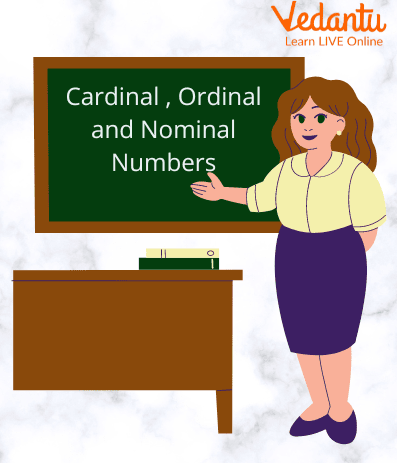




What Are Ordinal Numbers? Uses & Real-Life Examples Explained
The numbers that describe the positions of objects are known as ordinal numbers. Children learn to count from one to ten very quickly, and maybe they know the numbers from twenty-one to thirty also. But what are ordinal numbers? Ordinal numbers allow us to answer questions like "what is the 5th number in the set of numbers one through ten?" or "which number is greater: 7 or 14?"

Ordinal Numbers 1 to 20
If the number of things or people is given as a list, ordinal numbers are used to determine the order of the items or people. First - First, Second - Second, Third - Third, Fourth - Fourth, Fifth - Fifth, Sixth - Sixth, and so on are the adjective phrases that are used to express the order of something or someone. These phrases all refer to ordinal numbers examples. While the counting numbers, such as 0, 1, 2, 3, 4, and 5, are known as cardinal numbers. So as of now, we have seen the ordinal position definition and some examples based on the ordinal position definition. Now let’s see it in detail.
What are Ordinal Numbers?

Ordinal Numbers
An ordinal number, such as first, second, third, and so on, represents the place or order of something about other numbers. The size, importance, or any other chronology may determine the order or sequence.
Let's use an example to better understand ordinal numbers. Ten students took part in the competition. Out of these, the first, second, and third place winners each received a medal and were recognized. First, second, and third are ordinal numbers in this instance.
Difference Between Cardinal, Nominal, and Ordinal Numbers

Difference Between Cardinal, Nominal, and Ordinal Numbers
In addition to ordinal numbers, there are two other sorts of numbers that can be used to represent things or persons.
Cardinal Numbers
Nominal Numbers
Cardinal Numbers: Counting numbers that are used to indicate the number of individuals or items are known as Cardinal Numbers. They are as follows: 1, 2, 3, 4, 5, 6, 7, 8, 9, 10, and so on.
Nominal Numbers: The names given to the items in a group are given a numerical designation as nominal numbers. Example- Pin codes of different cities
Ordinal Numbers: The figures that represent an object or a person's position.
Example - Due to severe air pollution, the city placed second.
Ordinal Numbers Examples

Ordinal Numbers Examples
Here is the list of ordinal numbers examples used in sentences -
My birthday is on February 15th.
The third story of the structure is where the library is situated.
He attends sixth grade.
I finished second in the competition.
The following week marks my grandmother's 80th birthday.
January is the first month of the year.
When the new iPhone went on sale, my brother was among the first customers in line.
Begin by folding the piece of paper in half. The paper should now be folded twice.
Ordinal Numbers List

Ordinal Numbers List
Ordinal Numbers 1 to 20
1st: First
2nd: Second
3rd: Third
4th: Fourth
5th: Fifth
6th: Sixth
7th: Seventh
8th: Eighth
9th: Ninth
10th: Tenth
11th: Eleventh
12th: Twelfth
13th: Thirteenth
14th: Fourteenth
15th: Fifteenth
16th: Sixteenth
17th: Seventeenth
18th: Eighteenth
19th: Nineteenth
20th: Twentieth
Solved Examples
Q1. Fill in the blanks with correct ordinal numbers.
S is the ____ letter in the word NEST.
C is the____ letter in the word CLASS.
Ans:
S is the third letter in the word NEST.
C is the first letter in the word CLASS.
Q2. Sam, John, Mary, and Louis are the students of a class, standing in a row, in the given order. Who is in the second position?
Ans: If Sam, John, Mary, and Louis are standing in the given order, then John is in the second position.
Practice Problems
Q1. Write ordinal numbers from 1 to 20.
Ans: First, Second, Third, Fourth, Fifth, Sixth, Seventh, Eighth, Ninth, Tenth, Eleventh, Twelfth, Thirteenth, Fourteenth, Fifteenth, Sixteenth, Seventeenth, Eighteenth, Nineteenth, and Twentieth
Q2. In the word “BEAUTIFUL”, find the first and last letters.
Ans: The first letter is B and the last letter is L.
Summary
Ordinal numbers are used to denote the location or order of items or objects. These numbers display the order. Due to the positioning and status of objects, their purpose is to arrange various things in a logical order. Since the counting process requires the labeling of items with numbers, ordinal numbers provide precise location information when objects are arranged in order. Ordinal numbers are frequently used in science, literature, mathematics, and other fields.
FAQs on Ordinal Numbers 1 to 20 Made Simple: Step-by-Step Learning
1. What are ordinal numbers from 1 to 20?
Ordinal numbers tell us the position or order of an object or a number in a list. Unlike cardinal numbers that tell 'how many' (like 1, 2, 3), ordinals tell 'which one' in a sequence. For example, the first person in a line is in the 1st position.
2. How are the ordinal numbers from 1 to 20 written in words and symbols?
Here is the list of ordinal numbers from 1 to 20, written in both symbol and word form, as per the NCERT syllabus for early classes:
- 1st - First
- 2nd - Second
- 3rd - Third
- 4th - Fourth
- 5th - Fifth
- 6th - Sixth
- 7th - Seventh
- 8th - Eighth
- 9th - Ninth
- 10th - Tenth
- 11th - Eleventh
- 12th - Twelfth
- 13th - Thirteenth
- 14th - Fourteenth
- 15th - Fifteenth
- 16th - Sixteenth
- 17th - Seventeenth
- 18th - Eighteenth
- 19th - Nineteenth
- 20th - Twentieth
3. What is the key difference between an ordinal number and a cardinal number?
The main difference is their purpose. A cardinal number tells you the quantity of something, answering the question 'how many?'. For example, "There are five dogs." An ordinal number tells you the rank or position in a series, answering the question 'which one?'. For example, "The fifth dog in the line is the biggest."
4. Why do we use different endings like -st, -nd, -rd, and -th for ordinal numbers?
These special endings help us immediately recognise a number as an ordinal (positional) number. The rules are consistent and simple to learn:
- Use -st for numbers that end in 1 (e.g., 1st), except for 11th.
- Use -nd for numbers that end in 2 (e.g., 2nd), except for 12th.
- Use -rd for numbers that end in 3 (e.g., 3rd), except for 13th.
- Use -th for all other numbers, including those ending in 11, 12, and 13 (e.g., 4th, 11th, 12th, 20th).
5. Can you give some real-world examples of how ordinal numbers up to 20 are used?
Yes, we use ordinal numbers every day. Some common examples include:
- Stating the date, like "The 1st of January" or "September 15th".
- Describing the floors in a building, like the "12th floor".
- Announcing the winners of a race or competition (e.g., first, second, third place).
- Celebrating birthdays, for example, a "16th birthday" or "18th birthday".
- Identifying your position in a queue, like being the "tenth" person in line.
6. Why is it important for students to learn ordinal numbers?
Learning ordinal numbers is a fundamental skill that goes beyond just counting. It helps students develop an understanding of sequencing, ordering, and ranking. This is essential for following multi-step instructions, understanding concepts of time (like the first and last day of the week), reading calendars, and building a strong foundation for more advanced mathematical concepts.
7. If you are eighth in a line and three people in front of you leave, what is your new position?
If you are in the eighth (8th) position, it means there are seven people in front of you. When three of those people leave, there are now only four people (7 - 3 = 4) remaining in front of you. Therefore, your new position becomes the fifth (5th) in line. This shows how ordinal numbers help us understand changes in position.

















